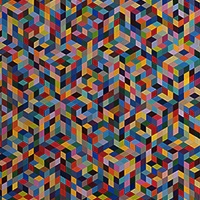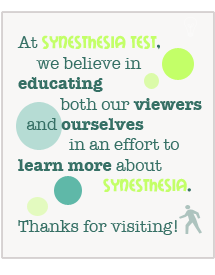Synesthetic Experiences – Involuntary & Consistent?
 Curious as to whether or not you have synesthesia? Looking for a synesthesia test to validate your suspicions or put them to rest? That’s all well and good. While our test is still in development, there are a few litmus tests (or questions, rather) that you can ask yourself before moving forward. The first of which is: Are my synesthetic experiences involuntary and consistent? Now, I realize that this question is quite ambiguous (in that it can be interpreted in a few different ways), so we’ll use the rest of this blog post to define each of these terms and clear up any misconceptions. Let’s get to it!
Curious as to whether or not you have synesthesia? Looking for a synesthesia test to validate your suspicions or put them to rest? That’s all well and good. While our test is still in development, there are a few litmus tests (or questions, rather) that you can ask yourself before moving forward. The first of which is: Are my synesthetic experiences involuntary and consistent? Now, I realize that this question is quite ambiguous (in that it can be interpreted in a few different ways), so we’ll use the rest of this blog post to define each of these terms and clear up any misconceptions. Let’s get to it!
Defining ‘Involuntary’
As there are two definitive elements to this question, we’ll address each individually. First up is the term ‘involuntary’. If experiences are involuntary, they aren’t a result of will, purposeful association, or mnemonic aptitude. In other words, you aren’t “trying” to experience or perceive something a certain way. Also, the experience usually isn’t one that’s naturally intuitive. For instance, if you associate the number ‘2’ with the letter ‘B’, it likely isn’t indicative of synesthesia. ‘B’ is the second letter in the alphabet; it only makes sense.
If, however, your experiences are triggered involuntarily (or by some external factor – separate from your own will), you may pass GO, collect $200, and spend it as you please. Maybe buy a loved one something nice for Valentine’s day – I don’t know; just an idea.
Defining ‘Consistent’
The consistency of your experiences can also be very telling. Neurologist and renowned synesthesia researcher, Richard Cytowic lists the following as one of the main criteria for identifying synesthesia: “Synesthetic percepts are consistent and generic.” The example that I use (probably too frequently) is the case of a true grapheme-color synesthete – for whom each letter in the alphabet triggers a given color in his or her mind’s eye. Now, each time the letter is physically seen, the synesthete perceives it as having one color – a color that is consistently and involuntarily associated with the particular letter. If the letter ‘A’ is red, it is always red. If ‘Z’ is yellow, it is always yellow. That’s consistency.
Since I’ve opened the ‘generic’ can, I’ll explain that, as well. The term ‘generic’ refers to percepts that are simple, rather than extravagant. For instance, when a given synesthete hears a certain tone, he or she might picture a black square in space. For another tone, perhaps an orange square is visualized. Notice the pattern? The shapes are simple, or generic – not grand visualizations of colors dancing around in harmony. While this concept has been disputed (and there are always exceptions), it’s certainly worth considering.
Moving Forward
Now that I’ve explained the question (or disambiguated it, if you will), ask yourself again: Are my synesthetic experiences involuntary and consistent? If not, well, you’re with the other 198 of us out of a 200 person sample size. If so, you might want to seek out more information about the condition. Either way, this is a great place to start.
If you enjoyed this post, please stop back! We’re in the process of developing an interactive test for synesthesia and would love it if you were around for its release! Follow us on Twitter for updates @SynesthesiaTest. Farewell, friends.





[…] in the synesthete’s mind. Typically, we might say that the sounds (or triggers) are more generic and defined, rather than multiple-minute compositions, but for our purposes, Burke’s compositions will be […]
I am going to dispute the phrase “percepts are simple, rather than extravagant.”
My concurrents to music can be very extravagant or very simple. Some are literally colored shapes dancing around complex grid patterns. Others are simple black and white patches. Some are so complex, they defy my ability to sketch or paint them accurately.
So some synesthetes may only see simple shapes, but others do not.
Your point is a good one, Pamela. While I’ve read that generic perceptions are standard, I’m certainly not trying to imply that all synesthetes’ perceptions are generic. Thanks for bringing this up for our readers! 🙂
I still feel my concurrents meet the criteria of being generic because they are made up of shapes, colors and grid patterns, spirals, etc.
I’ve always noticed that each number and letter would have its specific color and personality and recently I have been really interested in synesthesia when I found out one of my friends also had synesthesia. When I read the book by Wendy Mass: A Mango Shaped Space, that’s when I found out that there was a name for it. I researched it and found out that I have (and this is what I know for sure) Grapheme-color, Spatial Sequence, Misophonia, and Auditory-tactile Synesthesia. I thought it was so cool, but when I tried to explain it to my friends, it became frustrating and started asking questions like, “What’s the color of my name?” or asking what color for what number/letter and I would tell them, but then my friends would argue over what color to what number/letter when I was pretty positive they didn’t have synesthesia. When I hear noises or listen to music, each individual tone and note and pitch has its own color and shape in my mind, I don’t actually see it, like I could reach out and touch it, no. But I listen to music all the time and like, music with a lot of bass and beats would have darker colors while more classical music would have brighter colors. Some songs have both or just dark or just light. All the noise at the lunchroom during school is filled with browns and greens, but mostly yellows and oranges. I think its pretty cool and I want to learn more and tell my buds, but it becomes really confusing for them and frustrating for me. I love that each number and letter has a color and every word, ect. I think its pretty awesome! I dont really agree with the consistent thing, though. Because even though every letter always has its own color and every number does, but when Im in a negative mood or something, the words’ colors would change. Also, I might add, pain also has color for me. When I stub my toe or something, I would see yellow or orange in my mind depending on how bad in hurt. Once time when I was ice skating and I fell and hurt my shoulder, I saw gray dots all over my mind. I was wondering if anyone else has pain-colors, too?
I took your tests and some others and I think I have grapheme-color synesthesia. Thanks for helping! I like your post here. My colors for my numbers (and some letters) are always consistent, as well as the tastes. 🙂
Um, does anyone here know if seeing a light yellow or some other color literally ON something that’s black or white (ceiling, black paper, etc.) has anything to do with synesthesia? I see that, as well as when I’m reading I’ll see yellow dancing around on/between the letters on the paper (if the paper’s white, and the letters are black). And when it comes to graph paper, those lines have to be blue or something! I can’t concentrate with all that yellow running around! Any answers (please)?
All my numbers are colored and have personalities. 9 is even iredescent! I an see colors when I think of my friends/fam. Some of my letters have colors, too, and personalities. My colors (like blue) have personalities (blue is easily offended). My letters are male or female (depending on the way they’re written. It’s weird. It’s probably synesthesia. My friend has it, too. And when she tells me what her colors for her numbers/letters are, if they aren’t mine I’ll get a yucky taste in my mouth, like old leather that’s been sitting around for too long (even though I’ve never tasted old leather that’s been sitting around for so long). 😛 (tongue out because of the awful taste. It is too weird my experiences. But at least I can taste words without having to lick the object the word describes (if it’s a noun, although all words taste something mostly). My friend’s friend licked something metal to see what it tasted like! :))
So, I’m trying to figure out which type of synesthesia I have but don’t know. Please respond. I have a special smell for documentaries, it’s like a dusty staticy smell. Like when we’re watching one in school. I can also very rarely smell colors and never remember the smells. I am 12 years old. Thanks
So I don’t really know if my synesthesia is involuntary because I just got it this spring. I was coming home from a violin concert, and there was a song on the radio, and I just had this really strong feeling that it was supposed to be a light blue. After that, I started seeing color symphonies and lines whenever I heard music, and sometimes peoples voices. I asked my dad about it and he said I had synesthesia. I can’t hear the colors when I’m reading and listening to music, because I just faze about and don’t pay attention to the music at all. I’m 15 and co fused. Do I have synesthesia? I really need some help.